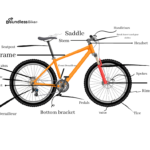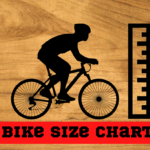Are you in the market for a new bike but unsure of what size frame to choose? Look no further than the trusty 26-inch bike! This classic bike size is perfect for riders of various heights and skill levels. In this blog post, we will explore the ideal 26 inch bike frame size for different individuals, as well as highlight some of the most common types of bikes available in this size. We’ll also provide tips on how to find the right 26 inch bike that fits your needs, budget and comfort level. So hop on and let’s ride into the world of 26-inch bikes!
26-Inch Bike For What Size Person

The 26-inch bike is perfect for individuals of various heights. However, it’s important to choose the right size frame to ensure a comfortable and safe ride. When selecting a 26 inch bike, consider your height as well as inseam measurement.
For riders between 4’5″ and 5’2″ tall, a small-sized frame with a seat tube length of around 14-15 inches is recommended. For those between 5’2″ and 5’10”, a medium-sized frame with a seat tube length of around 16-17 inches may be more appropriate. For taller individuals over 6′, look for larger frames with seat tubes measuring at least 18 inches.
It’s also essential to keep in mind that different styles of bikes may have slightly different sizing recommendations based on their intended use and riding position. So always double-check the manufacturer’s guidelines before purchasing your new ride!
What is the ideal 26 inch bike frame size for a person?
When it comes to finding the ideal 26-inch bike frame size for a person, there are a few factors to consider. The most important factor is rider height, as this will determine the overall fit and comfort of the bike.
According to the Bike Size Chart, riders who are between 5’2″ and 5’8″ generally require a 26-inch bike frame. However, it’s important to note that everyone’s body proportions are different, so this chart should be used as a general guideline rather than an absolute rule.
It’s also worth considering the type of riding you plan on doing with your 26-inch bike. For example, if you plan on using it primarily for mountain biking or off-road adventures, you may want to opt for a slightly smaller frame size for better maneuverability.
On the other hand, if you’re planning on using your bike mostly for road cycling or commuting purposes, a larger frame may provide more stability and comfort over longer distances.
| Wheel Size (Inches) | Age Range |
|---|---|
| 12 inches | 2-4 years |
| 14 inches | 3-5 years |
| 16 inches | 4-6 years |
| 18 inches | 5-7 years |
| 20 inches | 6-10 years |
| 24 inches | 8-12 years |
| 26 inches | 13+ years (adults) |
Bike Size Chart: for Rider Height and Bike Frame
When it comes to finding the perfect bike, size matters. A bike that is too small or too large can impact your comfort and performance on the road or trails. That’s why using a bike size chart based on your height and bike frame is crucial in determining which size of 26-inch bike you should get.
The chart typically includes recommended ranges for rider heights and corresponding frame sizes. It’s important to note that there may be some overlap between sizes, so it’s best to try out different bikes before making a final decision.
| Bike Size | Frame Size (Approx.) | Rider Height Range |
|---|---|---|
| XS | 13-15 inches | 4’10” – 5’4″ |
| S | 15-17 inches | 5’2″ – 5’8″ |
| M | 17-19 inches | 5’6″ – 6’0″ |
| L | 19-21 inches | 5’10” – 6’4″ |
| XL | 21+ inches | 6’2″ and above |
Keep in mind that not all bikes are created equal, so certain types may have slightly different sizing recommendations. For example, mountain bikes tend to have more relaxed geometry and longer top tubes compared to road bikes.
Using a proper fitting chart also takes into account factors such as inseam length and arm span, which can affect how comfortable you feel while riding.
Taking the time to consult a reliable bike size chart will pay off in terms of both comfort and performance while hitting the trails or cruising around town on your new 26-inch ride!
Most Common 26-inch Types of Bike

When it comes to 26-inch bikes, there are a few different types to choose from. The most common types of 26-inch bike include mountain bikes and road bikes.
Mountain Bikes
Mountain bikes are designed to handle rough terrain and steep inclines, making them the perfect choice for adventurers who enjoy off-road rides. These bikes have wider tires with deep treads that provide better traction on dirt, rocks, and gravel. Additionally, they typically feature a suspension system that helps absorb shocks while riding over bumpy trails.
One of the most significant benefits of mountain bikes is their versatility in terms of trail variety. You can take them through forests or up mountainsides without worrying about damage to your bike’s frame because it was built specifically for these types of environments.
When choosing a mountain bike frame size, consider the intended use as well as your height and weight. A larger frame may be more comfortable for taller riders but could also make handling difficult if you’re not used to it.
Another factor to keep in mind when buying a mountain bike is durability. The quality of materials used affects how long the bike lasts under heavy usage conditions. High-quality frames made from aluminum or carbon fiber tend to hold up better than cheaper models constructed from steel or other less durable metals.
Road Bikes
Road bikes are designed for speed and efficiency on paved roads, making them perfect for racing or long-distance rides. These bikes feature narrow tires and lightweight frames to minimize wind resistance and increase speed. The riding position is also more aerodynamic, with the handlebars positioned lower than the saddle.
One of the most popular types of road bike is a “drop bar” style, where the handlebars curve down and away from the rider. This design allows riders to switch hand positions frequently during long rides while maintaining an aerodynamic posture.
Other features commonly found in road bikes include multiple gears for tackling hills or adjusting to different speeds, as well as rim brakes that provide strong stopping power in dry conditions.
How To Find The Right 26 Inch Bike For You

When it comes to finding the right 26 inch bike for you, there are several factors to consider. First and foremost, think about what type of riding you will be doing most often. Will you primarily be hitting the trails on a mountain bike or cruising around town on a road bike? This will help narrow down your options.
Durability
Durability is one of the most important factors to consider when choosing a 26 inch bike frame. A durable bike can withstand various weather conditions and terrains, ensuring that it lasts for years. It’s essential to invest in a sturdy frame if you plan to use your bike frequently or engage in intense rides.
A high-quality frame made of steel, aluminum, or carbon fiber offers excellent durability. These materials are resistant to rust and corrosion and can handle rough roads. However, keep in mind that some materials may be heavier than others.
When choosing a 26-inch bike frame size, don’t overlook durability! Pay close attention not only on the material but also check thoroughly its overall build quality as this will ensure long-lasting performance during intense biking adventures keeping you safe while having fun at the same time!
High Quality Frame
A high-quality frame is essential when choosing a 26 inch bike. The frame determines the durability of the bike and how well it can withstand rough terrain. A poorly made frame can cause discomfort, poor handling, and even accidents.
When looking for a high-quality frame, consider the material used to make it. Steel frames are durable but heavy while aluminum frames are lighter and more affordable.
Another factor to consider is the welding process used to join the different parts of the frame together. Poor welding leads to weak joints that compromise safety.
The design of the frame also matters as it affects both comfort and performance. Look for frames with ergonomic designs that minimize pressure points on your body.
Wheel Strength
When it comes to buying a 26 inch bike, wheel strength is an important factor to consider. The wheels are the only contact point between the rider and the ground, so they must be strong enough to withstand any impact.
A good quality wheel should be able to handle rough terrain without bending or breaking easily. It’s essential for mountain biking enthusiasts who often ride on bumpy trails with rocks and roots that can damage weaker wheels.
The material of the rim also plays a crucial role in determining its strength. Aluminum rims are sturdy but not as durable as carbon fiber ones which offer more durability and stiffness while reducing weight at the same time.
When choosing your 26 inch bike, don’t overlook wheel strength as this is one of the most critical components that will affect your riding experience. Investing in high-quality wheels may cost you more initially but will save you from costly repairs down the line.
Weight Limit
When it comes to choosing a 26 inch bike, you need to consider the weight limit. It is important for your safety and comfort while riding. Every bike has a maximum weight capacity that it can handle.
If you exceed the weight limit of your bike, it can cause damage to the frame or wheels, which may lead to accidents or injuries. Therefore, always make sure that you buy a bike that supports your bodyweight.
The ideal way to determine if a particular 26-inch bike is suitable for you is by checking its product specification manual carefully. You should also consult with an expert before making any purchase decisions.
It’s worth noting that some bikes have lower-than-average weight limits than others due to material quality and construction design – so be mindful when shopping around!
Comfort
Comfort is an essential factor to consider when choosing a 26-inch bike frame. A comfortable bike can make your ride more enjoyable and reduce the risk of injuries or discomfort during long rides.
One aspect of comfort to take into account is the saddle. The saddle’s shape, size, and padding will play a crucial role in your overall comfort level while riding. Look for a seat that fits well with your body type and provides adequate support.
Handlebars also affect comfort levels as they impact posture and upper body position while cycling. Flat handlebars provide better control but may cause shoulder strain over long distances, whereas curved handlebars offer multiple hand positions making them ideal for recreational riders.
The suspension system on mountain bikes can provide additional shock absorption making them great choices for off-road terrain where bumps are common.
Budget
When it comes to buying a 26 inch bike, budget is an important factor to consider. Bikes come in varying price ranges and it’s easy to get carried away with the idea of owning an expensive one. However, it’s important to remember that you don’t need to break the bank for a good quality bike.
Setting a realistic budget can help narrow down your options and make the decision-making process easier. You should also keep in mind that additional expenses such as accessories, maintenance and repairs may arise after purchasing your bike.
One way to save money when buying a 26 inch bike is by opting for last year’s model or choosing from cheaper brands without sacrificing quality. Another option is looking for second-hand bikes which are often sold at lower prices but still offer great value.
It’s essential not to compromise on durability and strength of the frame just because of budget constraints. A strong frame ensures safety while riding and reduces costs on future repairs/replacements.
How To Measure For A 26 Inch Bike Frame Size?

Measuring for the right bike frame size is crucial for comfortable and efficient riding. To measure for a 26 inch bike frame, you need to get your inseam measurement. This is the distance from your crotch to your foot when standing flat against a wall.
Using a tape measure, measure this distance and multiply it by 0.65 to get an estimate of the ideal seat tube length, which is usually used as a reference point in sizing bikes.
Next, consider your riding style and intended use of the bike. If you’re going off-road on mountain trails, you may want to choose a slightly smaller frame that allows for more maneuverability. For road biking or commuting, choose a larger frame size that offers better stability at higher speeds.
It’s also important to take into account any physical limitations or injuries you may have that could affect your comfort while riding.
Ultimately, finding the right bike size requires some trial and error – don’t be afraid to test ride different sizes until you find one that fits perfectly!
What Are The Benefits of Riding A 26 Inch Bike?
Riding a 26 inch bike has numerous benefits that make it an ideal choice for many riders. For starters, these bikes are lightweight and easy to maneuver, which makes them perfect for both novice and experienced cyclists. Additionally, the smaller size of the frame means that less force is required to accelerate or decelerate.
Furthermore, 26 inch bikes are very versatile – they can be used on different types of terrain including roads and mountain trails. These bikes also offer a great deal of stability when riding at high speeds due to their lower center of gravity compared to larger bike frames.
Another significant benefit of riding a 26 inch bike is its affordability. These bicycles are relatively cheap compared to other sizes in the market while still offering excellent performance.
Moreover, cycling on a 26 inch bike provides you with numerous health benefits such as reducing stress levels and improving cardiovascular fitness. Riding regularly can also help improve your balance and coordination while strengthening your muscles.
There are plenty of reasons why choosing a 26 inch bike is an excellent decision for anyone looking for an affordable yet reliable bicycle that offers versatility, stability, maneuverability and health benefits all rolled into one package!
How to Choose a Perfect Bike Size?
Choosing the right bike size is essential for comfortable and safe riding. To determine your perfect bike size, you should consider a few things before making a purchase.
Firstly, you need to measure your height accurately. Stand with your back against a wall and mark the top of your head with a pencil or tape measure. Measure this distance in inches or centimeters and use it as a reference when selecting bikes.
Secondly, consider what type of bike you plan on using. Different types of bicycles have different frame geometries that affect their fit and comfort level for riders.
Thirdly, think about the length of time you plan on spending on the bike each day/week/month/year. The longer you ride, the more important it is to ensure proper sizing for maximum comfort.
Fourthly, take test rides! There’s no substitute for trying out different models in person to see which one feels best underfoot.
Is 26 Inch Good For Adults?

When it comes to bike frame sizes, one of the most common questions is whether a 26-inch frame is good for adults. The answer? It depends on your height and riding preferences.
Generally speaking, 26-inch frames are suitable for adult riders who are between 5’4″ and 6’2″ in height. This size offers a comfortable ride with enough clearance between the rider’s legs and the top tube.
However, if you’re taller or prefer a more aggressive riding position, you may find that a larger frame size better suits your needs. On the other hand, if you’re shorter or looking for a more casual ride, a smaller frame size might be ideal.
Is The 26 Inch Big Enough For A Man?
One of the most common questions asked when it comes to 26-inch bike frames is whether they are big enough for men. The answer depends on several factors including a man’s height, weight and cycling style.
For shorter men, a 26 inch bike frame may be suitable as it can accommodate riders between 5’2″ and 5’9″. However, taller men may find that a larger size is more comfortable.
It’s important to note that while the frame size is an essential factor in determining comfort, other components like handlebars and saddle height also play a significant role.
Another aspect to consider is the type of cycling you’ll be doing. If you’re planning on using your bike for leisurely rides or commuting short distances, then a smaller frame might work just fine. However, if you plan on tackling rough terrains or participating in long-distance races, then you may need to opt for something more substantial.
What age group is a 26-inch bike for?
Determining the right size of a bike frame is crucial to ensure that it fits the rider’s body comfortably and safely. When it comes to 26-inch bikes, one might wonder what age group they are intended for.
The truth is, there isn’t really an age group that 26-inch bikes are specifically made for. The size of the bike frame should be based on the rider’s height and inseam length rather than their age.
That being said, a 26-inch bike may be suitable for teenagers or shorter adults who have a height between 5’0″ to 5’6″. However, this also depends on individual body proportions as leg length and torso length can vary greatly from person to person.
It’s important not to rely solely on age when determining which bike frame size someone needs. It’s always best practice to measure your inseam length and compare it with the manufacturer’s sizing chart before deciding on which bike frame size is suitable for you or your child.
Conclusion
Choosing the right 26-inch bike frame size can be a daunting task, especially if it’s your first time buying one. However, with this guide at your fingertips, you should be able to make an informed decision that suits your needs and preferences.
Also Read: What Size Bike Frame For 6 Foot Man – Detailed Guide






